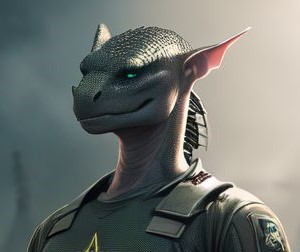The Mykentian people evolved on the world of Erd’os, which was renamed Mykentia following the reported death of
Mykentos. Once among the most prolific species of the galaxy, their population has generally collapsed and remains largely scattered in isolates Sanctuaries. Their appearance has altered greatly since the Great War of Erd’os, and the deliberate isolation of some populations has led to the development of distinct races.
Physical Form
Mykentians are evolved from mammalian, hexapedal omnivores which evolved to walk upright. This gives them the unusual trait of possessing four arms and a functional tail which is their most recognizable feature. The lower arms are generally used for lifting heavy objects, while the upper are typically used for more delicate, detailed work requiring agility, causing the upper arms to appear atrophied by comparison. The four arms causes the torso to be divided into two segments.
Both torso segments are protected by an internal carapace of overlaying segmented bone serving the function of a rib cage, but providing greater protection to the vital organs. The lower segment contains the primary lungs and heart, both capable of supplying the body while at rest. The upper segment contains a secondary heart and lungs, used when the body is exerting itself to supply additional oxygen. The double diaphragm and trachea allow the two sets of lungs to function independently, granting Mykentians the unusual ability of being able to inhale through the nose and exhale through the mouth simultaneously.
The chambers of the two, six chambered hearts are laid out vertically, each chamber increasing blood pressure. The lower heart provides the majority of the pumping force, while the upper increases it when needed.
The abdomen is covered by a thinner, more flexible carapace allowing for easy movement, but still protects vital organs from accidental damage. Mykentians also possess additional adrenal glands to provide extra energy.
The four arms end in four fingered appendages with opposable thumbs. The feet also possess thumbs, but these lack the dexterity to grip objects without specific training and practice. All six extremities feature thick nails, once grown long as claws but which are typically trimmed back.
While agile, the tail is where the body stores the majority of the fat, though in extreme cases it is also stored above the carapace in the abdomen and in the extremities. Most Mykentians are capable of gripping things with their tail, and it is a common gesture for them to use the tail to brush a seat before sitting on it.
The Mykentians originally possessed fur across their entire body, with long whiskers at the nose. Genetic damage caused by the radiation of the Great War caused them to lose this permanently, and to evolve a thicker, more leathery skin capable of blocking out most of the prevalent background radiation. This has given Mykentians the reptilian appearance most species are familiar with.
Mykentians are also prodigious breeders, capable of bearing as many as eight children at one time, with four or five being the most common. As in the Great War, population pressure and a shortage of resources has dropped this to one or two at a time. This is largely because the fetuses develop very quickly, and large numbers rapidly drain the mother’s nutrients causing the miscarriage of large numbers as the body tries to protect itself.
Mykentian genetics is highly adaptable to environments, resulting in accelerated evolution and frequent mutations. Industrialization during the Separate States and Hudrajel Periods led to a diminishing of the size of the tail as well as the atrophying of the lower arms. The harsh, constantly changing environment and the increased demand for physical labor in the Great War resulted in this process being quickly reversed, as well as the species rapidly adapting to the background radiation. The geneticists of Anatos would attempt to reverse this process through careful selective breeding in an effort to return to their pre-Great War appearance.
Sub-species
The genetic differences between the population of Anatos, later called Galatos is significant enough for the Galatian population to be considered a sub-species more than a race. This is why the genetically engineered Anatos Plague effected only the Galatian population. Conversely, the Galatian population would have been immune to the highly specific Terran Plague that killed most of the Mykentians in the fleet of Admiral Kosos.
Mykentians are genetically cousins of the dresit, which never evolved to walk upright. The Mykentians themselves would only realize this after the formation of the Republic and would ban their deliberate breeding and use as mounts. Following the abandonment after the fall of the Second Republic, most of the world of Mykentia would come to be populated mostly by herds of wild dresit.
Once believed to be a myth are the Nok’Sindro, or “Ones of Many Faces.” First appearing as a genetic aberration in the city of Mon’so immediately after the end of the Great War, Mon’so and later Monsos would deliberately breed this trait into a larger population. They would evolve to become shape shifters, able to blend into any population as sleeper agents. The most effective of these agents was Kanrekthos, known to the rest of the galaxy as the Hilt Katatoman.
The last Mykentian sub-species believed to have any significant population are the Do’lin’ka’dos. Highly elusive and largely relegated to myth, the Do’lin’ka’dos are described as highly intelligent winged Mykentians that live predominantly in the higher mountain ranges of the Ver Plateau, though legends have placed them in the Saros and Athos mountain ranges as well. The myths suggest an ancient agreement between the Mykentians and the Do’lin’ka’dos, where the Mykentians stay out of the high mountain ranges and the Do’lin’ka’dos do not come down from them. This may explain the Mykentians nascent fear of tall mountains.




Comments